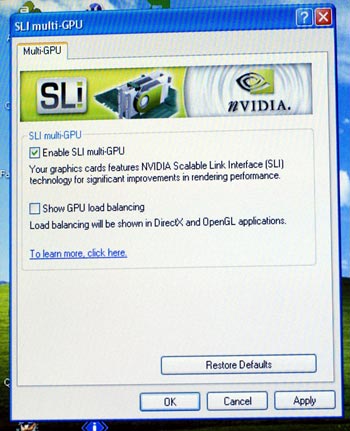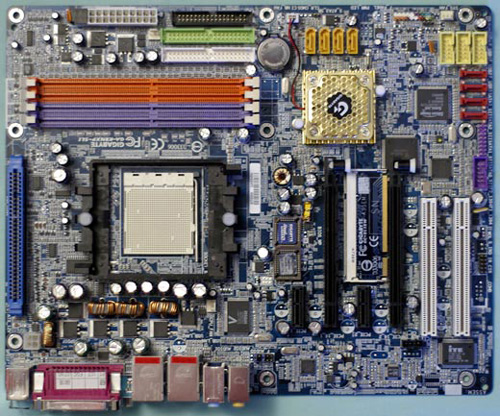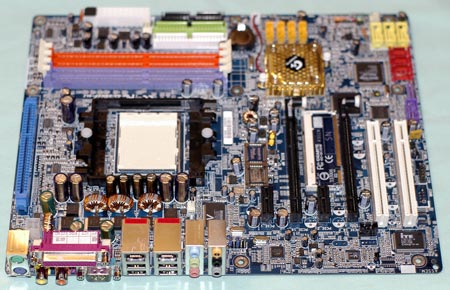FIRST LOOK: Gigabyte K8NXP-SLI
by Wesley Fink on November 24, 2004 9:00 PM EST- Posted in
- Motherboards
Features: Gigabyte K8NXP-SLI
Consider the K8NXP-SLI as an K8NXP-9 with SLI. Gigabyte has added all the BIOS options promised for the production boards and then some. Particularly interesting are the 0.5MHz increments available for very fine tweaking in the most used 200-270 CPU clock range, with 1MHz increments to the top speed of 400. The only item that proved too large a challenge for the production board was a wider range of memory voltages. Gigabyte states that future revisions of their nForce4 boards may see an increased memory voltage range, but that a boost in vDIMM options now would have required a board redesign. Gigabyte has tweaked the available vDIMM options to provide an adjustment range from 2.6V to 2.8V. As you will see in our overclocking tests, this had little impact on overclocking abilities, although a broader range is preferred and would have likely facilitated higher memory overclocking.| Gigabyte K8NXP-SLI Specifications | |
| CPU Interface | Socket 939 Athlon 64 |
| Chipset | nVidia nForce 4 Ultra (Single-Chip) |
| Bus Speeds | 200 to 400 200 - 270 in 0.5MHz increments 271 - 400 in 1MHz increments |
| PCI Express Speeds | 100 - 150 fixed in 1MHz increments |
| Core Voltage | 0.8V to 1.75V in 0.025V increments |
| CPU Clock Multiplier | 4x-20x in 1X increments |
| HyperTransport Frequency | 1000MHz (1GHz) |
| HyperTransport Multiplier | 1X, 2X, 3x, 4X, 5x, Auto |
| DRAM Voltage | 2.6V to 2.8V in 0.1V increments (Normal, +0.1, +0.2) |
| PCIe Voltage | Normal, + 0.1v, +0.2v, +0.3v |
| HyperTransport Voltage | Normal, + 0.1V, +0.2V, +0.3V |
| Robust Graphics Booster | Auto, Fast, Turbo |
| Memory Slots | Four 184-pin DDR DIMM Slots Dual-Channel Configuration Regular Unbuffered Memory to 4GB Total |
| Expansion Slots | 2 x8/x16 (Programmable) PCIe Slot 2 x1 PCIe Slots 2 PCI Slots |
| Onboard SATA/SATA RAID | 8 SATA Drive Total 4 SATA 300 Drives by nForce4 (RAID 0, 1, 0+1, JBOD) Can be combined with IDE drives in RAID 4 SATA 150 Drives by Sil3114CT176 (RAID 0, 1, 0+1, JBOD) |
| Onboard IDE/IDE RAID | Two Standard ATA133/100/66 (4 drives) Drives may be as IDE RAID or combined with nF4 SATA drives in a RAID Array |
| Onboard USB 2.0/IEEE-1394 | 10 USB 2.0 ports supported by nForce4 2 Firewire High-Speed 1394B by TI 46A9C3W |
| Onboard LAN | Dual Gigabit LAN On-chip Gigabit LAN by nF4/Cicada 8201 PHY PCI Express Gigabit LAN by Marvel 88E8053 |
| Wireless LAN | PCI 802.11b/g Wireless LAN Card Included |
| Onboard Audio | AC '97 2.3 8-Channel by Realtek ALC850 |
| BIOS Revision | Award K8NXP-SLI F2c 11/22/2004 |
The updated Gigabyte BIOS for the K8NXP-9/K8NXP-SLI family provides a very wide and useful range of adjustments for other features. Continuing with the Gigabyte custom in recent designs, Advanced Chipset Features (and Memory Timings) can only be seen when you press CTRL+F1 while in the BIOS. HyperTransport adjustments are also provided in the hidden Advanced Chipset Features menu.
There are no BIOS options for adjusting or controlling SLI. This is handled in the nForce4 platform drivers and the nVidia graphics drivers.
A new properties section appears in the Advanced properties GeForce tab for boards supporting SLI. This tells you that SLI is possible by installing a second video card. When the board between the PCIe video slots is turned to the SLI position and a second video card is installed with an SLI connector or bridge on top, new messages pop up telling you how to enable SLI.

The process is very easy, but don't assume that anything is wrong if you don't see SLI on the first boot. The first boot identified the video card. After we rebooted, the SLI was recognized and pop-ups led us though enabling SLI. The only boards currently working in SLI are the nVidia 6600GT, 6800GT, and 6800 Ultra. nVidia has stated that future 6800 video cards will also support SLI.
The Gigabyte K8NXP-SLI, like the sister K8NXP-9, was designed as a top-of-the-line nForce4 motherboard. As the flagship model, it sports all the top Gigabyte features.

The SLI version also supports the trademark DPS daughter to increase power reserves and stability by increasing the board to 6-phase power. You can see the DPS slot to the left of the CPU. You will also see dual BIOS chips to the left of the main PCIe video slot. This Gigabyte feature provides back-up BIOS in the event of a bad flash or unstable BIOS setting. The K8NXP-SLI can boot from the good backup BIOS if problems arise with the main BIOS.

Continuing the theme of "more than you might expect", Gigabyte provides eight SATA ports. Four ports are 3Gb/s ports provided by the nForce4 chip, and the other are four 1.5Gb/s ports driven by the PCI bus.
In the nForce4 family, Gigabyte adheres to nVidia's feature set. This time, we see Gigabyte use the nF4 on-chip Gigabit LAN by supporting it with a Vitesse (Cicada) Gigabit PHY. Gigabyte then goes one step further by including a second Gigabit LAN on the PCI Express Bus. This second LAN is also removed from the constraints of the slower PCI bus as it resides on the much faster PCIe bus.

Audio is AC '97 2.3, but Gigabyte uses the popular 8-channel Realtek ALC850. The K8NXP-SLI includes the same wide range of audio I/O provided on the K8NXP-9 to make the most of the 850 chip. This includes 6 programmable audio mini-jacks and coax SPDIF in and out - all on the rear panel. For more information on the Realtek 850, you can check the specifications at the Realtek web site.
Another pioneering feature for Gigabyte has been their support of high-speed 1394B Firewire on their boards. This continues with the K8NXP-SLI with 2 ports capable of 800MB/s. This is double the speed of 1394A, for those looking for fast Firewire access.
From a feature, board layout, and BIOS options point of view, the K8NXP-SLI can be considered the twin of the K8NXP-9. The only real change is the replacement of one PCI slot with a second PCIe video slot. All the good things about the features and layout of the K8NXP-9 are still here in the K8NXP-SLI.










58 Comments
View All Comments
bob661 - Thursday, November 25, 2004 - link
Actually, there were quite a few people that asked for resolutions higher than 16x12. I think for SLI benches, high res testing is probably the best. People that didn't read the initial article would get the wrong impression of SLI.Omega215D - Thursday, November 25, 2004 - link
what i'd like to know is when are they going to start phasing out those useless serial ports and maybe the LPT printer ports? I figure if your going to spend money on performance parts might as well get USB printers and game controllers.Also, any idea on when USB will be fully bootable that way PS2 ports can be phased out? Just wanna save on IRQs and make room for more USB's or Firewires so I don't have to rely on slot taking expansions.
Wesley Fink - Thursday, November 25, 2004 - link
#2 - Read on in the review. I did test at 1280 x1024 also because 1024x768 was limiting in some benches - but not as much as you might expect. The 1024x768 was provided mostly to allow comparison to past motherboard reviews.I believe most will run 1280x1024 which is doable with most 19" flat panels. The cheapest flat panel I know of that runs 1600x1200 resolution is the 20.1" Dell at about $750. That's 16x12 entry level.
Most any decent 19" CRT can support 1600x1200 as you stated, but have you ever tried to play a game at 1600x1200 on a 19" CRT. I tried it just to see for this review and it was pretty ugly. However 16x12 was OK on the 22" Diamondtron, though I prefer 1280x1024 on the 19" flat panels for most gaming.
Anand got criticized for gearing everything in his SLI launch review to 1600x1200, so it figures I would get criticized for 1280x1024 which was suggested in the comments on his review. Guess we will never please everybody.
AnnoyedGrunt - Thursday, November 25, 2004 - link
Well, this was a Mobo review, so that's one reason why it would make sense to run in resolutions that were CPU limited instead of video card limited. I doubt there would be much of a difference in SLI performance between the ASUS and Gigabyte solutions (although it certainly wouldn't hurt to have more data).-D'oh!
Decoder - Thursday, November 25, 2004 - link
#2 . I agree with you 100%. I run my Dell 2001FP at 1600x1200 and i will going SLI so that i can play games at 1600x1200 only.Decoder - Thursday, November 25, 2004 - link
cnq - Thursday, November 25, 2004 - link
"Since 1600x1200 normally requires a 20" or larger flat panel monitor, we did not report 1600x1200 results, since most readers will not run at that resolution."Wesley, with all due respect, there is not a single reader who is waiting to buy SLI who says to himself, "Boy I'd really like to see how fast SLI does at middling resolutions. Yeah, that's why I'm splurging thousands for an SLI rig. 1024x768 all the way baby!"
*ALL* SLI buyers will be running EVERYTHING at 16x12 or even 20x15, since current single card solutions can keep up at 10x7 and 12x10. No one would be dumb enough to pair up a couple of 68GT's or 68U's and then limit themselves to resolutions that a single 66GT could handle.
People who buy SLI are going to have money to spend, so don't worry, their monitors WILL be able to handle 16x12. An ordinary $250 19" CRT can do that, much less the kind of monitors that SLI fanatics will have.
Any SLI prospective purchasers out there planning to run their games at 1024x768? Didn't think so.
C'mon Wesley, really. You're doing quite a disservice benchmarking SLI at resolutions that aren't even graphics card limited in the first place.
HiroProt - Wednesday, November 24, 2004 - link
Great review, Wesley!Looks like Gigabyte has done it this time around. The question is: when can we buy these boards? I assume that the non-SLI version will be available first, since it already hit 1.0.
Do you have any more availability info, Wesley?